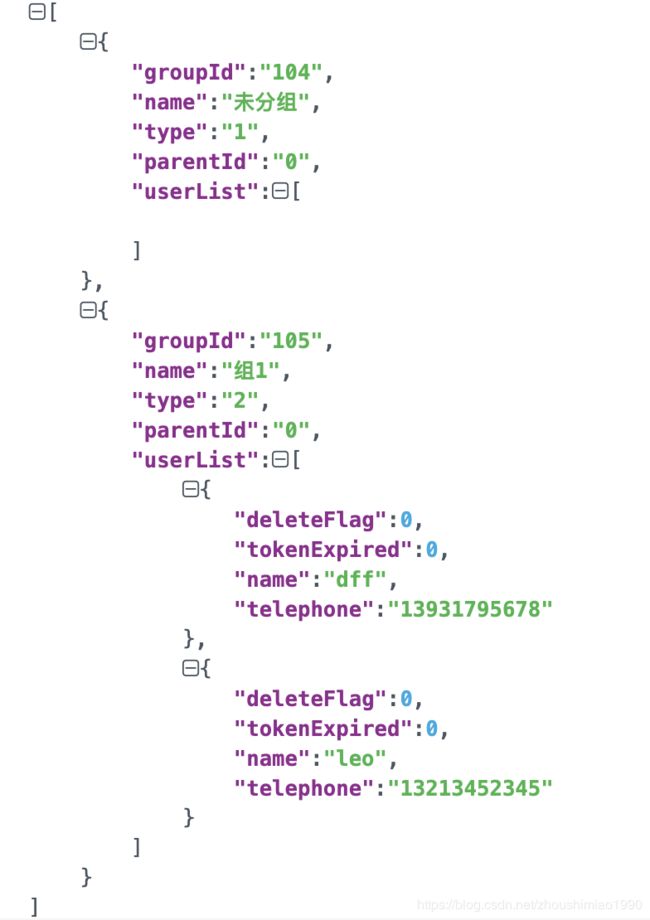Mybatis注解@Results、@Result、@ResultMap
先来看一组代码:
@Results(id="groupWithUsers",
value = {
@Result(property = "groupId", column = "group_id", id = true),
@Result(property = "name", column = "name"),
@Result(property = "accountId", column = "account_id"),
@Result(property = "deleteFlag", column = "delete_Flag"),
@Result(property = "parentId", column = "parent_Id"),
@Result(property = "userList", javaType=List.class, many =@Many(select="selectUsersByGroupId"), column = "group_id")})
//查询
@Select({"select * from group where account_id=#{accountId} and delete_flag=0"})
List selectGroupWithUsers(@Param("accountId") String accountId);
@Select({"select u.* from user u",
"inner join user_group ug on u.user_id = ug.user_id",
"where ug.group_id=#{groupId} and u.delete_flag=0"
})
List selectUsersByGroupId(@Param("groupId") String groupId); 我们的接受的对象Group中的字段:(User类中的映射关系这里就不再赘述)
@Data
public class Group {
private String groupId;
private String name;
private String accountId;
private String parentId;
private String type;
private List userList;
} 调用List
从结果中可以看出,查询出的列和Group中属性信息的映射关系是在@Results中value属性的@Result注解进行配置的,这里与mybatis的xml配置文件开发基本相同。再看一下userList包含了user信息,也就是selectUsersByGroupId方法被调用,查询结果被封装在Group类中的userList字段中。而selectUsersByGroupId方法被调用的配置在@Many注解中。下面我们来卓层分析一下@Results注解及注解中的属性信息:
@Results注解:
@Documented
@Retention(RetentionPolicy.RUNTIME)
@Target({ElementType.METHOD})
public @interface Results {
String id() default ""; //当前Results注解的唯一标识
Result[] value() default {}; //value值为Result[]数组
}@Results中只有两个属性,id和value,id作为当前@Results注解的唯一标识很好理解;value值为@Result数组,下面我们看一下@Result的信息:
@Result:
@Documented
@Retention(RetentionPolicy.RUNTIME)
@Target({})
public @interface Result {
boolean id() default false; //id唯一标识
String column() default ""; //对应数据库中的列名
String property() default ""; //对应类中的属性名
Class javaType() default void.class; //数据类型
JdbcType jdbcType() default JdbcType.UNDEFINED; //jdbc类型
Class typeHandler() default UnknownTypeHandler.class;
One one() default @One; //一对一配置
Many many() default @Many; //一对多配置
}@Result中常用的属性是column和property,用于配置数据库中的列名和类中的属性名之间的映射关系。另外one和many用于关联查询。比如上面列子中提到的Group类中包含属性List
@Result中many的应用:
@Many:
@Documented
@Retention(RetentionPolicy.RUNTIME)
@Target({})
public @interface Many {
String select() default ""; //选择要执行的方法
FetchType fetchType() default FetchType.DEFAULT; //枚举值,懒加载、及时加载、默认
}@Many中常用的属性只有selet,用于指定关联查询的方法
但是存在many属性的@Result注解的使用就有些变化:如下面的这段代码中,column属性的值为"group_id",是group表中的列,也是作为参数传递到selectUsersByGroupId中进行查询的参数。
@Result(property = "userList", javaType=List.class, many =@Many(select="selectUsersByGroupId"), column = "group_id")})如果select属性指定的方法需要的参数是一个对象,要如何传递参数?比如select属性绑定的是如下方法:
public List selectUsers(Map map); 需要的参数是一个Map对象,这时column属性的值要设置为:
column = "{groupId=group_id, userName=user_name}"这时,就相当于我们在map中传入了两个值map.put("groupId",value) ,map.put("userName",value),而column中,“groupId=group_id”,相当于将库中的列group_id映射到groupId中,user_name也一样。
至此,@Resuts和@Result的使用大致就这些,那么@ResultMap注解的使用,其实就是引用已定义好的@Results
@ResultMap:
@Documented
@Retention(RetentionPolicy.RUNTIME)
@Target({ElementType.METHOD})
public @interface ResultMap {
String[] value();
}@ResultMap中只有一个属性value,用于指定要引用的@Results,value值为@Results的id值,如下所示:
@ResultMap("resultsId")
@Select("......")
List
